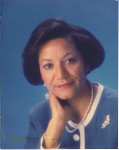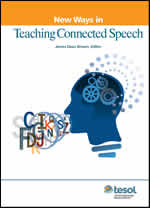New Year's Resolutions for Every English Language Teacher
by Suzanne Panferov
 “Be it resolved….”
“Be it resolved….”
Those are the words that start every Request for Action Item on the agenda of a TESOL board meeting. In short, if there is something that we want to take initiative on or if there is a change we want to put into place, a resolution is the formal future-looking official mechanism for making it happen. Once a resolution is passed, the idea, of course, is to fulfill it.
There is a tradition in my family of taking some time on December 31st of every year to reflect on the outgoing year and to set a list of resolutions for the coming new year. In my “work family” at the Center for English as a Second Language at the University of Arizona, we were recently discussing this practice of setting resolutions as well (not the formal official kinds from board meetings but ones in our personal lives). We investigated and found that this practice of setting personal resolutions goes back centuries but has always honored the past and welcomed the future.
For 2013, the faculty and coordinators at the Center for English as a Second Language at the University of Arizona have come up with a list of resolutions that we think fit every English teacher.
1. Commit to professional development
Making a conscious decision to focus on professional development can be difficult to do in the day-to-day rush of our lives. I will choose one particular professional topic to learn about each year and try at least once a month to read an article, a blog, or attend a workshop about that topic. (Fernanda Ortiz, Curriculum Coordinator)
2. Attend more conferences (but still keep my job)
We tend to focus on just the annual TESOL convention but among our affiliates, academies, and regional symposia, there are so many more conferences to choose from. Traveling to a different conference is a good way to meet new colleagues and to enjoy a mini professional vacation. (Linda Chu, Global Programs Development Officer)
3. Present at more conferences
It is tough getting presentation proposals accepted, but the more you submit, the more experience you get writing them, and the better your own acceptance rate gets. Presenting first locally and then nationally, or even internationally, is a good way to share knowledge and learn what others know about your topic. (Glen Piskula, Evening Program Coordinator)
4. Don’t fill up so much of the classroom with myself
As language teachers, we are all about talk. So, we all need to be mindful not to monopolize the time that our students need to practice English, and let the students express themselves more fully in class. I will try more often to walk around the room and physically provide space so that my students become the center of attention. (Mike Lindsey, Library Information Systems Coordinator)
5. Connect student language with opportunities to engage with their community and engage them in real world experiences
We teach a vital dynamic language that connects to our local and global communities in so many ways. Showing our students how to make those connections through volunteer opportunities, conversation partner exchanges, and other activities are good ways to demonstrate how English can engage them with the rest of the world. (Angel Miller Teacher Training Coordinator)
6. Make my students feel empowered by the language that they learn in the classroom
I will focus on making students realize how language can be empowering in the pursuit of their goals. Language is not just a means of communication, but an avenue to furthering careers and advancing studies. Bringing in guest speakers, especially alumni, is a good way to show students the opportunities that await them. (Martha Youman, New Initiatives Coordinator)
7. Find out about what colleagues at other universities do to develop and assess student learning
I think there is much that we can learn from each other across programs and institutions and countries. Assessing students can be approached from so many angles, from interviews in a hallway to standardized testing, and this is an area that every teacher needs to know more about. We need to know how our students are progressing in order to best teach to their needs. (Eddy White, Assessment Coordinator)
8. Learn more
Applying Zone of Proximal Development (ZPD) to myself, I learned English in the past. Now, through the same theory, I am determined to learn other subject matters. (Shirlëne Rossi, Graduate Student)
9. Find harmony in life and work
I have never met an English teacher who did not work too much or was not passionate about his or her students. Being able to find a balance and to be mindful of our health so that we can recharge and take care of ourselves as well as our students is vital. (Suzanne Panferov, President, TESOL International Association)
But one of my favorite resolutions comes from a theologian in 1716: “Resolved, to live with all my might, while I do live” (Jonathan Edwards). This may be the best resolution for all English teachers. All “our might”—in our classes, for our students, and for ourselves. I wish every English teacher the health, energy, and might to greet 2013 with such professionalism, optimism, and joy.
_________________________
Suzanne Panferov, President of TESOL International Association (2011–2014), is the Director of the Center for English as a Second Language (CESL) at the University of Arizona, Interim Director of the National Center for Interpretation, as well as a faculty member in the M.A. ESL Program and Ph.D. program in Second Language Acquisition and Teaching (SLAT). Panferov’s research focuses on language program administration, professional development, teacher training, pedagogy, and literacy acquisition.
TESOL Blogs
Interested in writing a blog for TESOL?
Contact
Craig Triplett or
Tomiko Breland with your idea or for details.
Check out the latest TESOL Blogs:
|
A Whole New World, by Tara Arntsen
 As a new blogger for TESOL, I want to take this opportunity to introduce myself to this wonderful community. My name is Tara Arntsen. I am currently pursuing a Master of Arts in TESOL online with the University of Southern California while teaching English as a foreign language to freshman at Guangdong Peizheng College in Guangzhou, China. I am from the United States but have spent more than 15 years living abroad including time teaching in Japan, Cambodia, and now China. Additionally, I have taught English online both as a freelancer and for various language companies. As a new blogger for TESOL, I want to take this opportunity to introduce myself to this wonderful community. My name is Tara Arntsen. I am currently pursuing a Master of Arts in TESOL online with the University of Southern California while teaching English as a foreign language to freshman at Guangdong Peizheng College in Guangzhou, China. I am from the United States but have spent more than 15 years living abroad including time teaching in Japan, Cambodia, and now China. Additionally, I have taught English online both as a freelancer and for various language companies.
With the importance of technology in our daily lives growing each year, I have become quite interested in technology and its role in education. I believe that teachers around the world, regardless of content area, should devote some time to this topic and develop their own skills as well as the skills of their students. Read More. |
|
Global Resources in ESP: Focus on Self-Directed Learning, by Kevin
 Hello, ESPers worldwide! Hello, ESPers worldwide!
One of my favorite things to tell my students is that they should study English 24/7 (24 hours a day, seven days a week). Of course, my students understand that I am exaggerating to a certain extent. However, I do want my students to make efforts outside of the classroom to learn English. Read More. |
|
The TESOL Symposium Facilitating Learning Through Student Empowerment: An Overview, by Maria Antonia Irizarry
 Editor’s Note: The symposium papers discussed in this blog posting are available in the TESOL Resource Center. Just click on “Find a Resource” and then in the top dropdown menu, choose “White Papers & Live Events.” Editor’s Note: The symposium papers discussed in this blog posting are available in the TESOL Resource Center. Just click on “Find a Resource” and then in the top dropdown menu, choose “White Papers & Live Events.”
The TESOL Symposium “Facilitating Learning Through Student Empowerment” was held in San Juan, Puerto Rico, on 15 November 2012 in partnership with the 36th PRTESOL Convention and the 11th Central American and Caribbean Basin Regional Conference. Read More. |
TESOL Bookstore
BRAND NEW RELEASE FROM TESOL PUBLICATIONS
 New Ways of Teaching Connected Speech
New Ways of Teaching Connected Speech
James Dean Brown, Editor
Connected speech is based on a set of rules used to modify pronunciations so that words connect and flow more smoothly in natural speech (hafta versus have to). Native speakers of English tend to feel that connected speech is friendlier, more natural, more sympathetic, and more personal. Is there any reason why learners of English would prefer to be viewed as unfriendly, unnatural, unsympathetic, and impersonal? The great news is that such rules can (and should) be explained and taught. This book makes available fun and interesting lessons, presented in a systematic way that is directly useful in the ESL/EFL classroom.
Endorsed by Nina Weinstein
Author of Whaddaya Say (Pearson)
Dr. Brown’s collection of articles includes sentence blending rules, assimilation, reduced forms, and other rules that comprise the natural pronunciation changes of real spoken English. These articles and classroom materials will give teachers a framework to prepare their learners to begin to understand real English speakers.
List $49.95; Member $38.50
Order from the TESOL Bookstore
Toll Free: 888-981-0041
E-mail: tesol@brightkey.net
Order #769
ISBN 9781931185769